Stealth Destroyer DDG-1000’s Biggest Trials Lie Ahead
Posted on
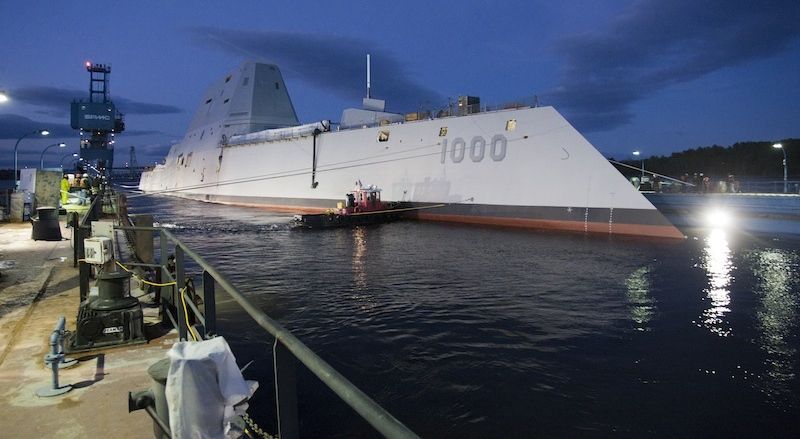
USS Zumwalt (DDG-1000)
WASHINGTON: As shipbuilder Bath Iron Works laid the keel for the third and final destroyer of the DDG-1000 class, the Navy and industry were struggling to understand embarrassing breakdowns on the first ship, the USS Zumwalt. Congress fears there could be worse to come. “The hard work hasn’t really begun yet in terms of delivering the capability of the ship,” frets one Hill staffer. “We don’t even know really what we don’t know yet about the combat systems because they hadn’t done testing.”
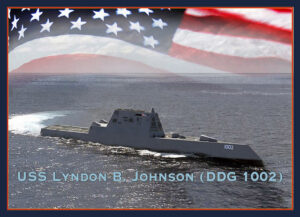
Illustration of the future USS Lyndon B. Johnson (DDG-1002)
The root cause of the problems may be something with which the F-35 program is very familiar: concurrency, developing and testing a weapon system at the same time. On DDG-1000, there are months of testing still to come even as the third ship, the future Lyndon Baines Johnson, is nearly 60 percent complete (in the form of pre-assembled modules yet to be attached to the keel). “There’s definitely a lot of concurrency,” the staffer said. “It’ll be two more years before combat systems delivery occurs, and then the ship can begin IOT&E (Initial Operational Test & Evaluation) and starting the training cycle to deploy.”
Naval Sea Systems Command is still working out the root causes of engine breakdowns that, among other things, required the $4 billion ship to be towed out of the Panama Canal. But that’s the easy part. What failed in Panama was a relatively simple component called a lube oil cooler, something ships have used “since Noah had an ark,” lamented NAVSEA’s commander, Vice Adm. Thomas Moore. What the Navy has yet to test — indeed, what the Navy has yet to turn on as a single, integrated, ship-wide system — is the ship’s far more complex array of unique, high-tech combat systems:
- the “integrated fight-through power” system to distribute the ship’s massive amount of electrical power to the highest-priority equipment while re-routing around battle damage, a lot like the fictional starship Enterprise;
- the two 155 mm Advanced Gun System (AGS) cannon, designed to fire rocket-propelled precision shells that proved so costly the Navy is looking at cheaper but shorter-ranged replacements;
- the AN/SPY-3 radar, which is new to the Zumwalt destroyers and the similarly troubled carrier USS Ford;
- and the unique ship-wide computer system meant to control it all, the Total Ship Computing Environment Infrastructure, with over five million lines of code, based on open-source Linux software.
Even when the Zumwalt appears to resemble earlier classes, it’s significantly different. For instance, the Mk 57 Vertical Launch System that allows the Zumwalt to fire a wide variety of missiles is slightly different than the Mk 41 VLS on the Navy’s mainstay warship, the DDG-51 Arleigh Burke class. In particular, the Zumwalt‘s missile tubes are squeezed in around the periphery of the ship, rather than forming one easy-to-load central block as on an Arleigh Burke.
“The combat system testing is a significant concern, since so much of it is new,” said Bryan Clark, a retired Navy commander now with the Center for Strategic & Budgetary Assessments. “The Mk57 VLS launcher, AGS, SPY-3, and volume search radar are all unique to DDG-1000. While each system has been tested individually to some degree, the integration testing of all these new systems is likely to identify unforeseen problems, and subsequent delays in the ship’s first deployment.”
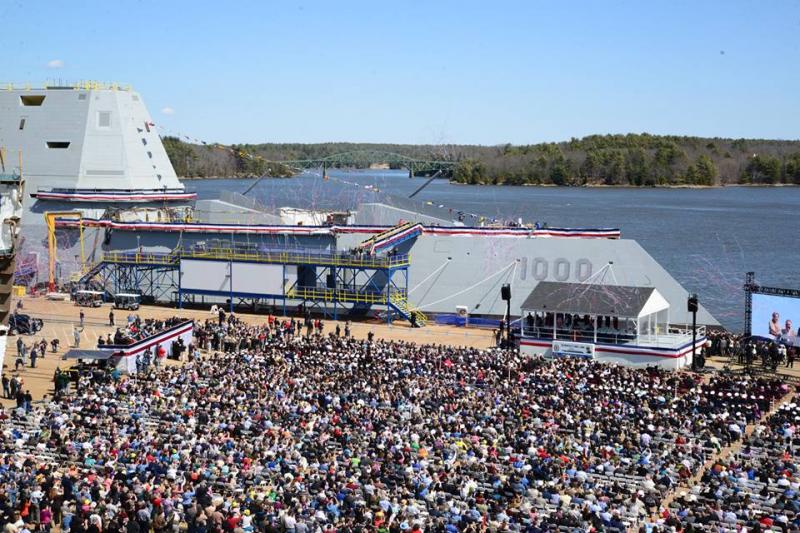
DDG-1000 at Bath Iron Works
Guns and Voltage
Even once everything is working and all systems are go aboard ship, Clark continued, the Navy will need to build a support infrastructure on shore. That means special training programs for the crews of the three DDG-1000s, distinct from other destroyers, he said, “because of all the DDG-1000’s unique systems, including a different electrical system, generators, propulsion system, combat systems, and hull equipment.” The DDG-1000 even draws a different voltage of power from other destroyers, he said, which means it’ll compete for high-voltage pier space with big-deck amphibious assault ships and nuclear-powered aircraft carriers.
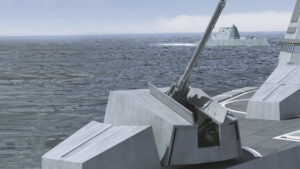
Advanced Gun System (AGS) 155 mm turret on DDG-1000 (BAE graphic)
Then there’s the cost of ammunition. The ship was built around its two 155 mm guns, a caliber used by no other ship in the Navy. The Advanced Gun System in turn was built to fire a unique hybrid of artillery shell and missile, the rocket-boosted Long-Range Land-Attack Projectile (LRLAP), able to strike targets about 100 nautical miles away. Unfortunately, as the DDG-1000 program kept getting cut back, and the production run of ammo with it, the cost-per-round rocketed to somewhere around $800,000. Now the Navy’s not actually buying LRLAPs and instead looking at the Excalibur round, which is precision-guided but not rocket-boosted: Excalibur costs about $70,000 a shot — less than 10 percent the LRLAP’s price — but can hit targets at most 26 nautical miles away — about 25 percent the LRLAP’s range.
That’s a tactical tradeoff that undermines the whole raison d’etre of the Zumwalt class, shore bombardment, argued naval historian and analyst Norman Polmar. “Less range? It doesn’t have enough range now (with LRLAP)!” Polmar told me. With everyone from China and Russia to Lebanese Hezbollah and Yemeni Houthis boasting anti-ship cruise missiles nowadays, “amphibious forces have to stay at least 25 and preferably 50 miles off shore,” Polmar said. With modern aircraft like the V-22 Osprey and the CH-53K helicopter, he went on, “we’re not going to land troops on the beaches…. We’ve got a capability of going more than a 100 miles inland easily.” So adding the distance ships must stand out to sea and the distance ground forces will go inland, you get ranges that even the LRLAP couldn’t cross, let alone Excalibur.
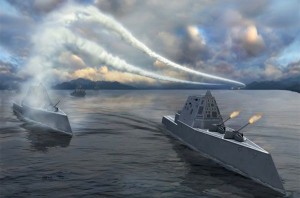 So what does DDG-1000 do? “It was designed for a mission that’s no longer relevant,” Polmar said, but bombardment of land targets with big guns isn’t the only mission the Zumwalt can do. Take away the guns and, “what do you have? A large ship with a lot of electricity,” he said. “The ship has phenomenal capabilities in terms of its power plant, so let’s get rid of the guns and let’s start putting lasers and other high-tech weapons on the ship.”
So what does DDG-1000 do? “It was designed for a mission that’s no longer relevant,” Polmar said, but bombardment of land targets with big guns isn’t the only mission the Zumwalt can do. Take away the guns and, “what do you have? A large ship with a lot of electricity,” he said. “The ship has phenomenal capabilities in terms of its power plant, so let’s get rid of the guns and let’s start putting lasers and other high-tech weapons on the ship.”
“The best things about DDG-1000 have to do with its electrical power (76MW) and internal volume,” agreed Clark. “It will be a great testbed and developmental platform for electric weapons like lasers, high-power radio frequency weapons, and railguns.”
The Hill staffer wasn’t so sure: “The idea that you would reopen the shipbuilding contract to put in a railgun begs for more trouble” on a program that’s already seen plenty. (That doesn’t rule out expensively extracting the 155mm guns and replacing them with railguns later, though).
On the other hand, the contract structure and the advanced state of construction makes it impractical to cancel the third ship, as the Pentagon once studied doing. “(DDG-)1001 and 1002 both are on fixed price contracts,” the staffer said. “The idea of not building the third one doesn’t make any sense; we’ve already paid for it” — all but $200 million — “so we’d better get a ship.”
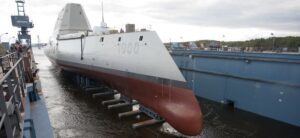
The USS Zumwalt in the drydock at Bath Iron Works in Maine.
So what, at this stage, can be done to fix and improve the Zumwalt class? The Navy is reviewing the ships’ missions and studying Concepts of Operation (CONOPS), which will likely reflect the reduced range of the guns. Congress will watch the combat systems testing closely, and it’s already reformed one aspect of shipbuilding. After the Navy commissioned the Zumwalt in October and formally accepted delivery of the ship from Bath, Congress enacted language in the 2017 National Defense Authorization Act (Section 7301) defining delivery to occur only when “all systems contained” are ready and ordering the Navy to amend the Zumwalt class’s delivery dates accordingly. That statute should help prevent concurrency from rearing its troublesome head on future shipbuilding programs.
Then there’s the longer-term lesson of the DDG-1000 and similarly ambitious ships like the aircraft carrier Ford and the Littoral Combat Ship. On both sides of the Potomac, the emerging consensus is that the hoped-for 355-ship fleet should be built with incremental upgrades of proven classes, not with more ambitious, leap-ahead ships packed with new technologies like the Zumwalt.
“I think the ship has a lot of potential,” the Hill source said, “but we shouldn’t believe it until we see it demonstrated.”
Subscribe to our newsletter
Promotions, new products and sales. Directly to your inbox.
